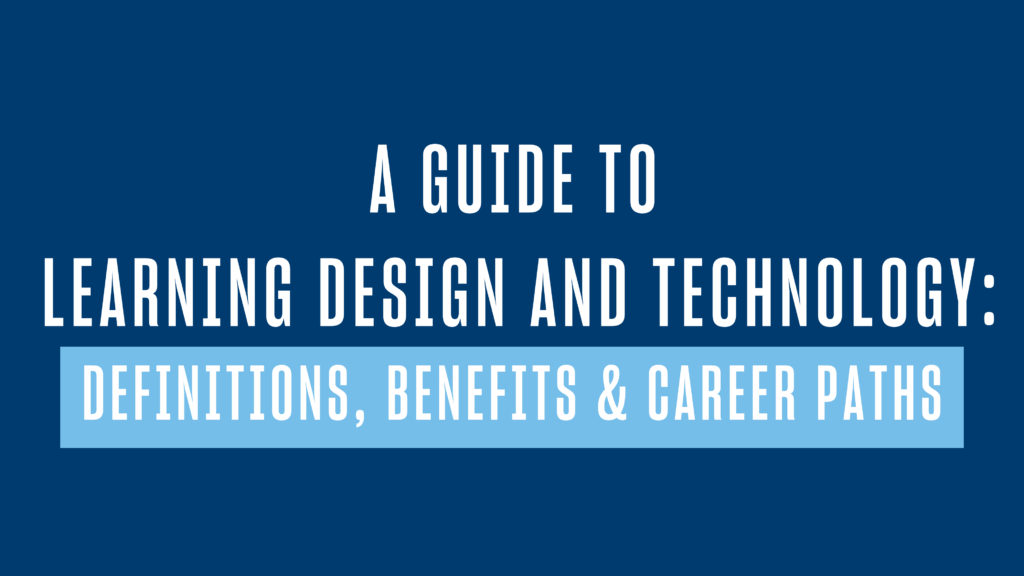There’s a reason that Inside Higher Ed called instructional design “the hottest job in higher education.” According to the U.S. Bureau of Labor Statistics, there’s expected to be a 6% job growth for instructional designers through 2029 — and that’s just for fields in education and government. Instructional designers are also increasingly in demand across private industry and the corporate world, as the BLS also projects a 9% growth for training and development specialists along the same timeframe.
Advances in digital communication and instructional technology have contributed to a significant hiring boom for IDs in all areas — including in state and federal governments as well as the nonprofit sector. With such a high projection of job growth across such a wide array of fields, now is a great time to consider pursuing an instructional design career.
Top 10 Instructional Design Careers & Salaries
Depending on which fields you get into, your specializations, or what level you get hired at, you’ll have different job responsibilities and salary expectations. Here are 10 possible instructional design career paths in addition to what you can expect as an estimated median salary.
Salary estimates vary widely and are often updated in real time; salaries shown here are as of September 2021 from Glassdoor.com.
- Instructional Designer – median salary of $71,081 per year.
IDs are expected to oversee the effectiveness of instructional and training solutions, from a high-level project management approach down to individual course and curriculum design. Responsibilities include analyzing data, working with subject matter experts, designing instructional strategies, developing eLearning content, conducting training for others, integrating technology into teaching and training environments, and evaluating new learning technologies - Instructional Technologist – median salary of $61,592 per year. Instructional technologists are responsible for the effective integration of hardware–such as computers and tablets–as well as software programs and applications into educational environments. They work directly with training department managers or faculty to determine how technology can fit in and enhance the curriculum and how to meet different learner needs, including federally mandated accessibility standards.
- Training and Development Specialist – median salary $62,700 per year. These specialists plan, conduct and administer corporate programs related to employee training and development. They also review training materials from different sources, evaluate current training programs and research possible new technology tools and resources.
- Training and Development Manager – median salary $79,122 per year. As a higher level position that oversees the training and development of staff, managers ensure that all development goals are being met and coordinate directly with senior management and executives. They’re also responsible for creating and managing the training budget, updating training programs, teaching best practices to instructors and supervisors and evaluating the overall effectiveness of the training programs.
- Learning Consultant – average base pay $69,556 per year.
Also referred to as an educational consultant, learning consultants are brought in to work directly with educators to ensure that all instructional design goals are being met. They’ll evaluate existing curriculum and resources, analyze performance metrics and then make recommendations to implement new or updated learning initiatives to improve results. - Corporate Trainer – average base pay $46,901 per year.
As a more on-the-ground instructional position, corporate trainers provide training directly to employees. They can also work with employers to help design and coordinate their professional development programs. As part of the job, they’re expected to be knowledgeable about organizational training goals and current training methodologies. - Director of Instructional Design – average base pay $113,398 per year. As a senior-level position, directors of instructional design are responsible for overseeing the design, planning and assessment of courses and programs offered across an institution or organization. They review the performance of instructional designers and ensure that outcomes across all relevant courses meet established learning design goals.
- eLearning Developer – average base pay $68,391 per year.
Focused on digital instruction, eLearning developers are responsible for designing and developing interactive and engaging online courses using authoring software and other learning technologies. They must be comfortable using multimedia development tools and software to create instructional content for multiple learning modalities. - Director of eLearning Development – average base pay $85,647 per year. As the heads of a department, directors oversee development of all eLearning, including online, web-enhanced and hybrid instruction. They must manage the development, implementation and evaluation of all eLearning initiatives as well as coordinate with other senior positions to build new eLearning opportunities.
- Distance Learning Specialist – average base pay $56,963 per year. Focused on facilitating distance learning, these specialists provide resources and training to ensure that instructors and learners are able to access instructional content whenever necessary. They oversee class materials, software and technology to make sure they’re appropriate to the course needs and accessible for all learners.
[PDF GUIDE] Wondering which career fits you best? Explore the exciting opportunities in instructional design.
Industries Where Instructional Design Professionals Are Needed
With a history in military training, instructional design continues to evolve along with prominent views of how people learn. Instructional designers are now sought after and valued by higher education institutions, corporations across all industries (including healthcare, retail, entertainment), nonprofit organizations, and government agencies.
Some of the larger areas hiring for learning/instructional design jobs include:
- Software & tech development
- Banking & financial services
- Social media
- Consulting services
- Government agencies, including the FBI
- Health care
- Higher education
- Nonprofit and community organizations
Companies Hiring Instructional Designers Right Now
According to LinkedIn, as of February 2022, the following companies had listed positions for instructional designers:
- LinkedIn, Omaha NE
Base pay range $64,900/yr – $96,800/yr - Apple, Austin TX
Base pay range $72,700/yr – $111,000/yr - Xerox, Fairfax VA
Base pay range $48,900/yr – $106,000/yr - Meta, Austin TX
Base pay range $72,400/yr – $132,000/yr - Delta Airlines, Atlanta GA
Base pay range $53,900/yr – $69,300/yr - Harvard University, Boston MA
Base pay range $60,400/yr – $103,000/yr - Amazon, Bellevue WA
Base Pay Range $56,600/yr – $118,000/yr
On any given day, searching for instructional design jobs can result in more than 30,000 listings for positions at places like Salesforce, Netflix, Humana, J.P. Morgan, Wayfair, Barnes & Noble, Deloitte, Blackboard and even more universities, community colleges, and corporate employers.
[RELATED RESOURCE] Ready to join a fast-growing field? Learn how instructional design offers high pay and meaningful work.
Education Requirements for Instructional Designers
Instructional design is a profession requiring competency in:
- Communicating effectively
- Collecting and analyzing data
- Selecting and applying the appropriate design, development, and evaluation process
- Connecting theory to practice
- Evaluating learner and program outcomes
- Managing the project development cycle.
Given the requisite skill set, a bachelor’s degree is considered the minimum level of education for any instructional design position. For those interested in pursuing a career as an instructional designer, a graduate degree can open the door to more opportunities for employment and advancement.
A survey of 853 instructional design professionals found that 87% had earned a master’s degree. One report by the Learning Guild found that 68% had either a master’s degree or doctorate, while a later report showed that each level of degree earned resulted in an average $3,000 more in yearly salary.
While it’s possible to find work as an instructional designer with a bachelor’s degree, those interested in a higher instructional designer salary or advanced position should consider a master’s degree, such as the Master of Science in Learning Design and Technology offered by the University of San Diego.
Advance Your Instructional Design Career with USD LDT
USD has launched an innovative, online Master of Science in Learning Design and Technology degree program that is designed to meet the needs of aspiring learning designers. We are well-established leaders in online education, and are continually improving our top-quality online degree programs, as well as creating innovative new ones in response to demand.
If you want to be at the forefront of learning and instructional design and make the case that you’re worth a top-level instructional designer salary, then take a look at what we have to offer.
Helpful Instructional Design Resources
Learn more about the field of instructional and learning design with a look at the following organizations and resources:
The Learning Guild (https://www.learningguild.com/)
A community of practice for those supporting the design, development, strategy and management of organizational learning.
Articulate eLearning Heroes Community (https://community.articulate.com/)
An open community for collaboration and practicing eLearning skills with the Articulate 360 platform.
Association for Educational Communications and Technology (https://www.aect.org/)
A professional association of instructional designers, educators and professionals who provide leadership and advise policy makers in order to enrich teaching and learning.
Online Learning Consortium (https://onlinelearningconsortium.org/)
A collaborative community of higher education leaders and innovators, dedicated to advancing quality digital teaching and learning experiences.
United States Distance Learning Association (https://usdla.org/)
A nonprofit distance learning association that supports distance learning research, development across education, training and communications.
Training Magazine: The Source for Professional Development (https://trainingmag.com/)
A professional development magazine that advocates training and workforce development as a business tool
The American Journal of Distance Education (https://www.tandfonline.com/loi/hajd20)
Open access academic journal that studies distance learning and communication that takes place through technologies.
FAQs
Q: Can instructional design techniques apply in-person as well as online?
A: Yes they can. Though much of instructional design is migrating to the digital realm, there is still an ongoing need for in-person instruction. A master’s program is designed to teach you theory and skills in learning design that are applicable to any learning environment.
Q: What is the ADDIE model of instructional design?
A: ADDIE stands for analyze, design, develop, implement and evaluate. It is arguably the most widely used model when developing effective training solutions. This USD LDT blog post offers an in-depth review of ADDIE and other instructional design models.
Q: What software applications and technology tools do IDs use?
A: There are several different options for instructional design software, each with their own impressive array of features, functions and capabilities. Two of the most widely used are:
- Articulate 360 is a popular suite of software tools used to build eLearning courses.
- Captivate is Adobe’s HTML-based course design software used to create eLearning content.
Q: What Is the difference between learning design vs. instructional design vs. curriculum design?
A: All three terms are associated with creating effective instructional materials that help people learn. While the terms are closely related, there are some important differences between them:
- Instructional Design — fundamentally, this is the creation of learning or instructional experiences that facilitate a change in knowledge, skills, or attitudes. The work of instructional design determines the “how” of learning, including alignment of learning objectives, content, tasks, strategies and assessment.
- Learning Design — this is ID with the added consideration of user experience. Learning design focuses on the needs of the learner, in a human-centered and goal-oriented experience that considers learning tasks, resources and systems of support. It’s used to promote a more human-centered and creative thinking approach to learning solutions.
- Curriculum Design — also known as curriculum development, this is a specific focus on the learning materials of a course, class or training that determines the overall learning goals, content, criteria and evaluation methods. Curriculum design, or the “what” of learning, is focused entirely on the material, its scope and sequence, and strategies for presenting the content.

![Top 10 Instructional Design Careers [+ Salary Guide]](https://onlinedegrees.sandiego.edu/wp-content/uploads/2022/03/ldt_blog_top10idcareers.png)

![Top Jobs and Careers in Learning Design and Technology [+ Salary Info]](https://onlinedegrees.sandiego.edu/wp-content/uploads/2021/08/ldt_blog_topjobsld-1024x576.png)

![What Does an Instructional Designer Do? [Career Info & FAQs]](https://onlinedegrees.sandiego.edu/wp-content/uploads/2021/08/ldt_blog_whatdoesiddo-1024x576.png)